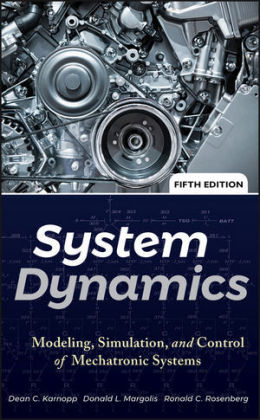
System Dynamics
John Wiley & Sons Inc (Verlag)
978-0-470-88908-4 (ISBN)
Dean C. Karnopp and Donald L. Margolis are Professors of Mechanical Engineering at the University of California, Davis. Ronald C. Rosenberg is Professor of Mechanical Engineering at Michigan State University. The authors have extensive experience in teaching system dynamics at the graduate and undergraduate levels and have published numerous papers on the industrial applications of the subject.
Preface xi 1 Introduction 1 1.1 Models of Systems, 4 1.2 Systems, Subsystems, and Components, 7 1.3 State-Determined Systems, 9 1.4 Uses of Dynamic Models, 10 1.5 Linear and Nonlinear Systems, 11 1.6 Automated Simulation, 12 References, 13 Problems, 14 2 Multiport Systems and Bond Graphs 17 2.1 Engineering Multiports, 17 2.2 Ports, Bonds, and Power, 24 2.3 Bond Graphs, 27 2.4 Inputs, Outputs, and Signals, 30 Problems, 33 3 Basic Bond Graph Elements 37 3.1 Basic 1-Port Elements, 37 3.2 Basic 2-Port Elements, 50 3.3 The 3-Port Junction Elements, 57 3.4 Causality Considerations for the Basic Elements, 63 3.4.1 Causality for Basic 1-Ports, 64 3.4.2 Causality for Basic 2-Ports, 65 3.4.3 Causality for Basic 3-Ports, 66 3.5 Causality and Block Diagrams, 67 Reference, 71 Problems, 71 4 System Models 77 4.1 Electrical Systems, 78 4.1.1 Electrical Circuits, 78 4.1.2 Electrical Networks, 84 4.2 Mechanical Systems, 91 4.2.1 Mechanics of Translation, 91 4.2.2 Fixed-Axis Rotation, 100 4.2.3 Plane Motion, 106 4.3 Hydraulic and Acoustic Circuits, 121 4.3.1 Fluid Resistance, 122 4.3.2 Fluid Capacitance, 125 4.3.3 Fluid Inertia, 130 4.3.4 Fluid Circuit Construction, 132 4.3.5 An Acoustic Circuit Example, 135 4.4 Transducers and Multi-Energy-Domain Models, 136 4.4.1 Transformer Transducers, 137 4.4.2 Gyrator Transducers, 139 4.4.3 Multi-Energy-Domain Models, 142 References, 144 Problems, 144 5 State-Space Equations and Automated Simulation 162 5.1 Standard Form for System Equations, 165 5.2 Augmenting the Bond Graph, 168 5.3 Basic Formulation and Reduction, 175 5.4 Extended Formulation Methods Algebraic Loops, 183 5.4.1 Extended Formulation Methods Derivative Causality, 188 5.5 Output Variable Formulation, 196 5.6 Nonlinear and Automated Simulation, 198 5.6.1 Nonlinear Simulation, 198 5.6.2 Automated Simulation, 202 Reference, 207 Problems, 207 6 Analysis and Control of Linear Systems 218 6.1 Introduction, 218 6.2 Solution Techniques for Ordinary Differential Equations, 219 6.3 Free Response and Eigenvalues, 222 6.3.1 A First-Order Example, 223 6.3.2 Second-Order Systems, 225 6.3.3 Example: The Undamped Oscillator, 230 6.3.4 Example: The Damped Oscillator, 232 6.3.5 The General Case, 236 6.4 Transfer Functions, 239 6.4.1 The General Case for Transfer Functions, 241 6.5 Frequency Response, 244 6.5.1 Example Transfer Functions and Frequency Responses, 249 6.5.2 Block Diagrams, 255 6.6 Introduction to Automatic Control, 258 6.6.1 Basic Control Actions, 259 6.6.2 Root Locus Concept, 273 6.6.3 General Control Considerations, 285 6.7 Summary, 310 References, 311 Problems, 311 7 Multiport Fields and Junction Structures 326 7.1 Energy-Storing Fields, 327 7.1.1 C-Fields, 327 7.1.2 Causal Considerations for C-Fields, 333 7.1.3 I -Fields, 340 7.1.4 Mixed Energy-Storing Fields, 348 7.2 Resistive Fields, 350 7.3 Modulated 2-Port Elements, 354 7.4 Junction Structures, 357 7.5 Multiport Transformers, 359 References, 364 Problems, 365 8 Transducers, Amplifiers, and Instruments 371 8.1 Power Transducers, 372 8.2 Energy-Storing Transducers, 380 8.3 Amplifiers and Instruments, 385 8.4 Bond Graphs and Block Diagrams for Controlled Systems, 392 References, 397 Problems, 397 9 Mechanical Systems with Nonlinear Geometry 411 9.1 Multidimensional Dynamics, 412 9.1.1 Coordinate Transformations, 416 9.2 Kinematic Nonlinearities in Mechanical Dynamics, 420 9.2.1 The Basic Modeling Procedure, 422 9.2.2 Multibody Systems, 433 9.2.3 Lagrangian or Hamiltonian IC -Field Representations, 440 9.3 Application to Vehicle Dynamics, 445 9.4 Summary, 452 References, 452 Problems, 453 10 Distributed-Parameter Systems 470 10.1 Simple Lumping Techniques for Distributed Systems, 471 10.1.1 Longitudinal Motions of a Bar, 471 10.1.2 Transverse Beam Motion, 476 10.2 Lumped Models of Continua through Separation of Variables, 482 10.2.1 The Bar Revisited, 483 10.2.2 Bernoulli Euler Beam Revisited, 491 10.3 General Considerations of Finite-Mode Bond Graphs, 499 10.3.1 How Many Modes Should Be Retained?, 499 10.3.2 How to Include Damping, 503 10.3.3 Causality Consideration for Modal Bond Graphs, 503 10.4 Assembling Overall System Models, 508 10.5 Summary, 512 References, 512 Problems, 512 11 Magnetic Circuits and Devices 519 11.1 Magnetic Effort and Flow Variables, 519 11.2 Magnetic Energy Storage and Loss, 524 11.3 Magnetic Circuit Elements, 528 11.4 Magnetomechanical Elements, 532 11.5 Device Models, 534 References, 543 Problems, 544 CONTENTS ix 12 Thermofluid Systems 548 12.1 Pseudo-Bond Graphs for Heat Transfer, 548 12.2 Basic Thermodynamics in True Bond Graph Form, 551 12.3 True Bond Graphs for Heat Transfer, 558 12.3.1 A Simple Example of a True Bond Graph Model, 561 12.3.2 An Electrothermal Resistor, 563 12.4 Fluid Dynamic Systems Revisited, 565 12.4.1 One-Dimensional Incompressible Flow, 569 12.4.2 Representation of Compressibility Effects in True Bond Graphs, 573 12.4.3 Inertial and Compressibility Effects in One-Dimensional Flow, 576 12.5 Pseudo-Bond Graphs for Compressible Gas Dynamics, 578 12.5.1 The Thermodynamic Accumulator A Pseudo-Bond Graph Element, 579 12.5.2 The Thermodynamic Restrictor A Pseudo-Bond Graph Element, 584 12.5.3 Constructing Models with Accumulators and Restrictors, 587 12.5.4 Summary, 590 References, 592 Problems, 592 13 Nonlinear System Simulation 600 13.1 Explicit First-Order Differential Equations, 601 13.2 Differential Algebraic Equations Caused by Algebraic Loops, 604 13.3 Implicit Equations Caused by Derivative Causality, 608 13.4 Automated Simulation of Dynamic Systems, 612 13.4.1 Sorting of Equations, 613 13.4.2 Implicit and Differential Algebraic Equation Solvers, 614 13.4.3 Icon-Based Automated Simulation, 614 13.5 Example Nonlinear Simulation, 616 13.5.1 Some Simulation Results, 620 13.6 Summary, 623 References, 624 Problems, 624 Appendix: Typical Material Property Values Useful in Modeling Mechanical, Acoustic, and Hydraulic Elements 630 Index 633
| Erscheint lt. Verlag | 9.3.2012 |
|---|---|
| Verlagsort | New York |
| Sprache | englisch |
| Maße | 168 x 246 mm |
| Gewicht | 1048 g |
| Themenwelt | Technik ► Elektrotechnik / Energietechnik |
| Technik ► Maschinenbau | |
| ISBN-10 | 0-470-88908-X / 047088908X |
| ISBN-13 | 978-0-470-88908-4 / 9780470889084 |
| Zustand | Neuware |
| Haben Sie eine Frage zum Produkt? |
aus dem Bereich



